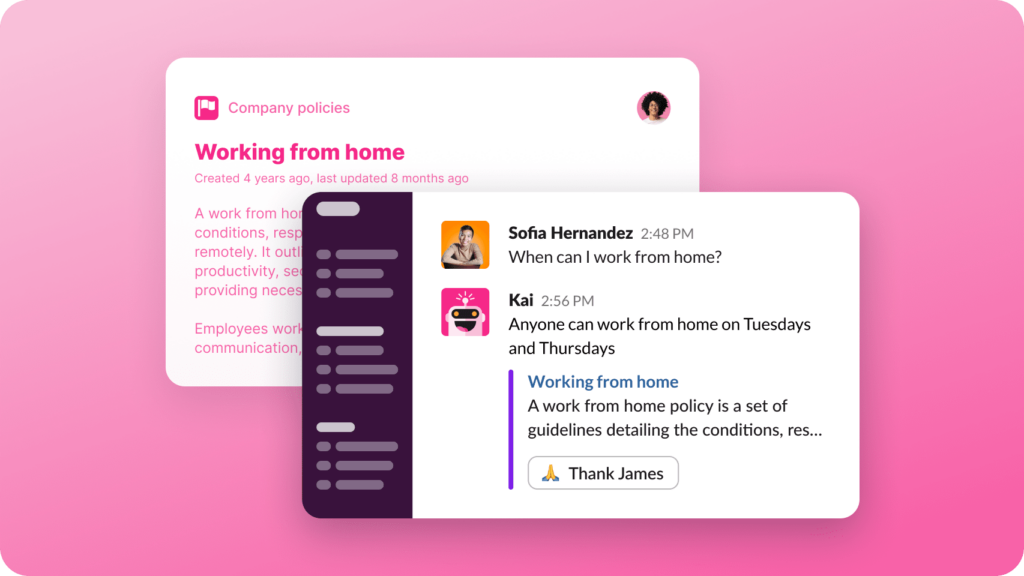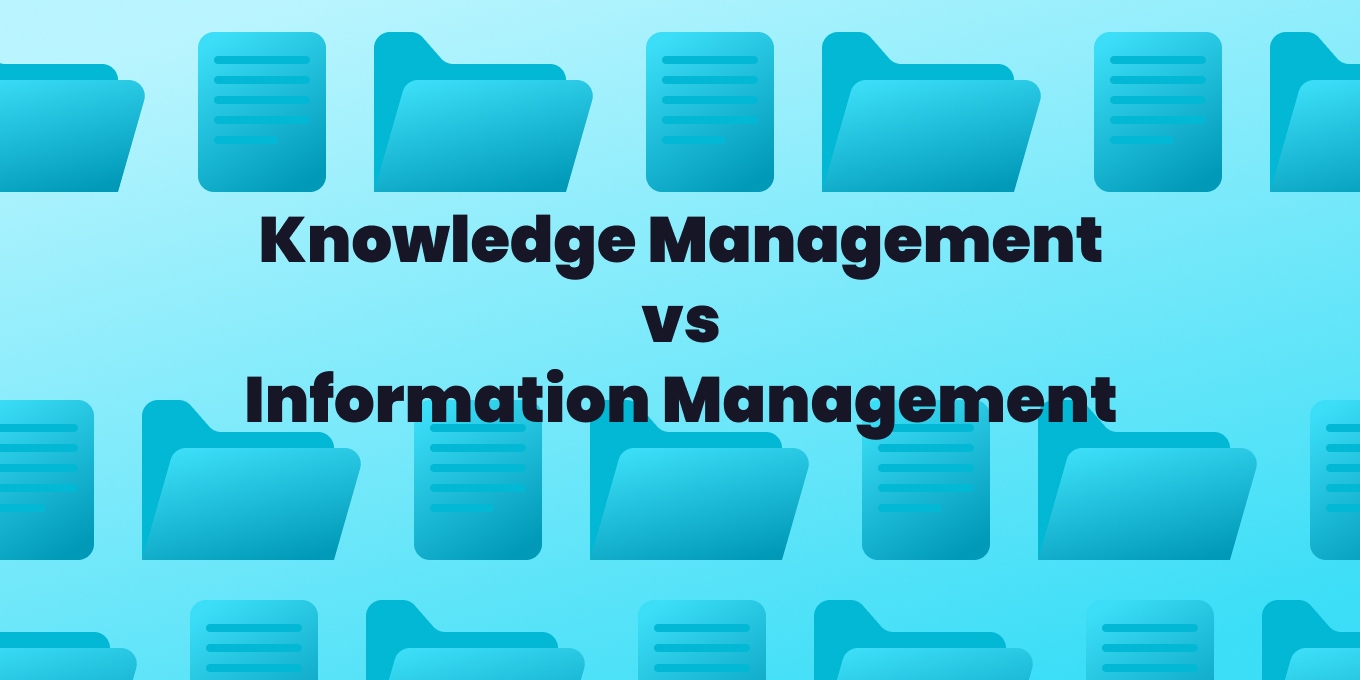It’s an understatement to say that businesses are flooded with both information and knowledge.
This substantially increased during the COVID-19 pandemic, as more and more businesses took more and more of their data and information online.
Statistia estimates that data storage reached 64.2 zettabytes in 2020 and is projected to almost double by 2025.
However, businesses don’t know what to do with all of this information. They just…get it and then delete it.
The same research study found that companies keep only 2% on average of the data generated, meaning that management of data, knowledge and information is also at an all-time high.
If companies had better management practices for their knowledge and information, they could leverage more of these insights.
Thomas Redman, also known as the “Data Doc” suggested in the Harvard Business Review that companies woefully mismanage their data, and instead need to think of it like they would any physical asset.
“Just as companies track the producers and raw materials, they rely on to manufacture and deliver physical products, they should define and track how data is created, how it moves from one place to another, and how it is analyzed and used along the way,” he says.
What’s the difference between knowledge management and information management?
While they may seem synonymous, they have distinct differences, particularly when it comes to management.
Knowledge management and information management are crucial for business operations, but they serve different purposes, have varied focuses, goals, and utilize distinct technologies.
At its core, information management emphasizes the explicit characteristics of data and hard facts. This raw data can be measured quantitatively in short time frames. It focuses on collecting, categorizing, and distributing specific pieces of information that can be readily used for decision-making or operational activities. Examples include database systems and cloud storage solutions.
On the other hand, knowledge management is more intricate. It incorporates not just facts, but also opinions, intuitions, and experiential wisdom. Unlike the clear-cut nature of information, knowledge is often measured by changes in behavior and work over extended periods. The main goal of knowledge management is to tap into the collective wisdom of an organization, facilitating the sharing and utilization of experiences. Technologies here often include collaborative tools, forums, or knowledge-sharing platforms.
Information Management:
- Data Handling: Collection, storage, retrieval, and distribution of data.
- Structured Systems: Use of databases, content management systems, and data warehouses to organize and store information.
- Focused on Accuracy: Ensures that data is consistent, reliable, and without duplication.
- Protection: Implements security measures to safeguard data and ensure privacy.
- Compliance: Ensures adherence to data protection regulations and industry standards.
- Efficiency: Facilitates easy and quick access to needed data.
Knowledge Management:
- Tacit & Explicit Knowledge: Involves both unspoken expertise (tacit) and documented information (explicit).
- Organizational Learning: Encourages continuous learning and sharing within an organization.
- Collaboration: Facilitates sharing of experiences, insights, and expertise among team members.
- Cultural Aspect: Encourages a culture where knowledge sharing is incentivized.
- Knowledge Bases: Utilizes platforms, forums, or knowledge-sharing systems to document and share organizational wisdom.
- Decision-making: Aids in informed decision-making by leveraging collective experience and expertise.
- Related: Other benefits of knowledge management
Advantages of Effective Knowledge and Information Management
Harnessing the power of both knowledge and information management can unlock unprecedented benefits for businesses. Here’s a deep dive into some advantages:
Improved Productivity & Efficiency
Effective management of knowledge and information is directly proportional to enhanced productivity and efficiency. When employees can easily access relevant information or tap into the collective experience of their colleagues, they save countless work hours. Knowledge management allows businesses to foster a culture of innovation by building upon collective experiences. This, in turn, provides faster access to information, reduces the chances of mistakes, and ensures informed decision-making. By streamlining access to crucial data and shared experiences, businesses can significantly improve their processes, leading to evident growth in productivity and efficiency.
Reduced Costs & Risks
A well-structured knowledge and information management system is not just about increasing efficiency; it’s also about cost-saving and risk mitigation. Information management, with its explicit characteristic, helps in slashing costs by offering readily accessible and quantifiable data, ensuring that decisions can be made swiftly and without incurring additional expenses.
Knowledge management, on the other hand, plays a pivotal role in risk reduction. It leverages the tacit knowledge of employees – knowledge that’s unique and can’t be easily replicated. By understanding and using this tacit knowledge, businesses can foresee potential challenges, devise strategies to circumvent them, and ensure smoother operations without unforeseen pitfalls.
Other advantages of knowledge management and information management:
1. Enhanced Customer Service:
- Knowledgeable staff can respond quickly and accurately to customer inquiries.
- Centralized information systems provide consistent and reliable responses across customer touchpoints.
2. Competitive Edge:
- Access to organized knowledge enables faster and better decision-making, setting companies apart in the market.
- Allows companies to identify trends and insights before competitors.
3. Employee Empowerment:
- Employees have access to tools and knowledge, reducing their dependence on supervisors for every query.
- Encourages a sense of ownership and responsibility.
4. Facilitates Onboarding:
- New employees can get up to speed quicker when there’s a system in place for knowledge transfer.
- Reduces the learning curve, leading to faster integration into teams.
5. Encourages Innovation:
- With easy access to both historical data and collective experiences, employees can brainstorm and innovate more effectively.
- Prevents “reinventing the wheel” by building on existing knowledge.
6. Preservation of Intellectual Property:
- Ensures that valuable insights, strategies, and proprietary knowledge are retained within the organization, even if key employees depart.
7. Enhanced Collaboration Across Departments:
- Breaks down silos by promoting cross-functional knowledge sharing.
- Encourages interdisciplinary projects and initiatives.
8. Risk Management:
- Knowledge of past mistakes, challenges, and solutions can guide teams to avoid pitfalls.
- Enables proactive identification and mitigation of potential issues.
9. Improved Resource Utilization:
- Reduces redundancy by ensuring resources aren’t spent on gathering the same data or knowledge multiple times.
- Helps in identifying gaps and allocating resources more efficiently.
10. Supports Continuous Improvement:
- Regular feedback loops, combined with shared knowledge, can lead to iterative improvements in processes, products, or services.
In essence, effective information and knowledge management not only enhance operational efficiency but also foster a culture of continuous learning and collaboration, driving long-term success in an organization.
While knowledge management and information management have distinct focuses and functionalities, both are indispensable for modern businesses.
By understanding their nuances and leveraging their strengths, businesses can drive growth, innovation, and resilience in an increasingly complex business environment.
Why Use Tettra for Your Knowledge Management?
Tettra is a game-changer in the realm of knowledge management. Positioned as a centralized knowledge hub, Tettra simplifies the process of capturing, organizing, and sharing information across teams.
With its user-friendly interface, collaborative features, and integrations with popular tools like Slack, teams can document their processes, decisions, and insights.
As a result, businesses benefit from reduced knowledge silos, improved onboarding experiences, and a culture of continuous learning, ensuring that crucial information is always accessible and up-to-date.
Tettra offers a full suite of tools for sharing knowledge. With Tettra, you’ll get:
- AI-powered knowledge base software to document answers
- Q&A workflow to capture questions
- Knowledge management features to keep content up to date.
- Integrations with Slack, MS Teams, Google Docs, Github and Zapier to help your team answer and capture knowledge quickly
The addition of AI into Tettra has changed the way teams work forever.
Upload your company knowledge docs and then start using Kai, Tettra’s AI assistant, to find the information you need in everyday, plain language.

Learn more about how AI and Tettra work together for better knowledge and information management.


